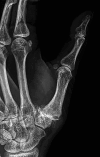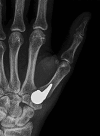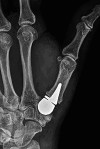Early Clinical Failure of a Cementless Thumb Basal Joint Hemiarthroplasty for the Treatment of Trapeziometacarpal Osteoarthritis
- PMID: 40487143
- PMCID: PMC12136669
- DOI: 10.2106/JBJS.OA.25.00001
Early Clinical Failure of a Cementless Thumb Basal Joint Hemiarthroplasty for the Treatment of Trapeziometacarpal Osteoarthritis
Abstract
Background: The purpose of our study was to evaluate the clinical results and survivorship of a metal-stemmed implant for thumb basal joint hemiarthroplasty.
Methods: We performed 35 basal joint hemiarthroplasties in 32 patients. Of these, 26 thumbs (25 patients) had clinical follow-up of at least 12 months at our first review in 2014. The mean age of the patients was 54 years (range 43-68 years), and 88% were females. All patients had Eaton-Littler Stage II or III arthritis preoperatively. Average follow-up was 22.5 months (range 12-41 months) for the initial review and 144.4 months (range 126-160 months) for the last chart review and phone follow-up. The main outcomes were revision rate and time to revision. Preoperative and postoperative radiographs were examined to determine the amount of overall thumb ray lengthening and amount of subsidence of the implant between those revised and unrevised.
Results: At 12-month follow-up, 16 of 26 thumbs (61.5%) had been revised with implant removal, resection of the remaining trapezium, and ligament reconstruction with tendon interposition. Another 3 thumbs were symptomatic and planning on future revision. Continued pain, stem loosening, and implant subsidence into the trapezium were the clinical reasons for revision. The mean time to revision was 18.1 months (range 8-41 months).
Conclusions: We found poor implant survivorship and an unacceptably high rate of reoperation with the stemmed thumb basal joint hemiarthroplasty device in our patient cohort.
Level of evidence: Therapeutic Study-Level IV Case Series. See Instructions for Authors for a complete description of levels of evidence.
Copyright © 2025 The Authors. Published by The Journal of Bone and Joint Surgery, Incorporated. All rights reserved.
Conflict of interest statement
Disclosure: The Disclosure of Potential Conflicts of Interest forms are provided with the online version of the article (http://links.lww.com/JBJSOA/A834).
Figures









Similar articles
-
A promising thumb Basal joint hemiarthroplasty for treatment of trapeziometacarpal osteoarthritis.Clin Orthop Relat Res. 2012 Oct;470(10):2756-63. doi: 10.1007/s11999-012-2367-7. Epub 2012 May 15. Clin Orthop Relat Res. 2012. PMID: 22585348 Free PMC article. Clinical Trial.
-
Cementless, Cruciate-Retaining Primary Total Knee Arthroplasty Using Conventional Instrumentation: Technical Pearls and Intraoperative Considerations.JBJS Essent Surg Tech. 2024 Sep 13;14(3):e23.00036. doi: 10.2106/JBJS.ST.23.00036. eCollection 2024 Jul-Sep. JBJS Essent Surg Tech. 2024. PMID: 39280965 Free PMC article.
-
Total joint arthroplasty in the treatment of advanced stages of thumb carpometacarpal joint osteoarthritis.J Hand Surg Am. 2006 Dec;31(10):1605-14. doi: 10.1016/j.jhsa.2006.08.008. J Hand Surg Am. 2006. PMID: 17145380
-
Failure Rates of Base of Thumb Arthritis Surgery: A Systematic Review.J Hand Surg Am. 2019 Sep;44(9):728-741.e10. doi: 10.1016/j.jhsa.2019.05.003. Epub 2019 Jun 28. J Hand Surg Am. 2019. PMID: 31262534
-
Thumb trapeziometacarpal arthritis: treatment with ligament reconstruction tendon interposition arthroplasty.Plast Reconstr Surg. 2006 May;117(6):116e-128e. doi: 10.1097/01.prs.0000214652.31293.23. Plast Reconstr Surg. 2006. PMID: 16651933 Review.
References
-
- Spaans AJ, van Laarhoven CMCM, Schuurman AH, van Minnen LP. Interobserver agreement of the eaton-littler classification system and treatment strategy of thumb carpometacarpal joint osteoarthritis. J Hand Surg Am. 2011;36(9):1467-70. - PubMed
-
- Dela Rosa TL, Vance M, Stern P. Radiographic optimization of the Eaton classification. J Hand Surg Br. 2004;29(2):173-7. - PubMed
-
- Ulrich-Vinther M, Puggaard H, Lange B. Prospective 1-year follow-up study comparing joint prosthesis with tendon interposition arthroplasty in treatment of trapeziometacarpal osteoarthritis. J Hand Surg Am. 2008;33(8):1369-77. - PubMed
-
- Igoe D, Middleton C, Hammert W. Evolution of basal joint arthroplasty and technology in hand surgery. J Hand Ther. 2014;27(2):115-21. - PubMed
LinkOut - more resources
Full Text Sources
Research Materials
